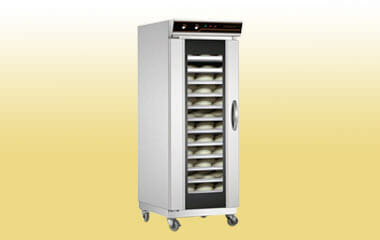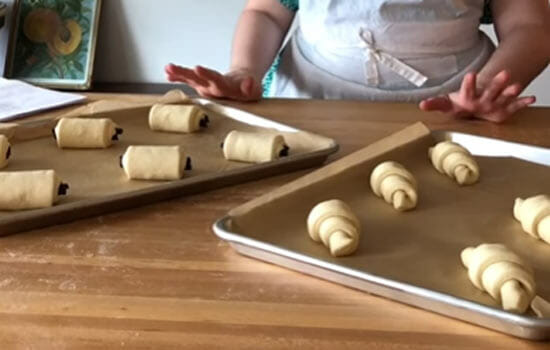It’s simple to make the Croissants dough happy. Give them the most effective environment and see them rise. It can be found naturally or be created.
Once they get the right one, you can easily achieve those airy, springy, and puffy textures with flavors being buttery and delicately sweet.
Hence, it doesn’t need a proofer but a little effort to proof it.
It’s known as bench proofing where the dough is fermented without a proofer.
You just need to make a note of your weather and opt for the best method accordingly. It’s okay if you don’t want to spend some bucks on a proofer. Have a look around your home, you will find many options and places where the croissants can grow nicely.
So, prep yourself now to know how to proof croissants without a proofer!!! It’s time to up bread your proofing game!
Ideal Environment To Proof Croissants

As we mentioned, you can either have the ideal environment naturally, or you can create it.
For croissants, make sure it’s within 75°F to 95°F temperature with a 70% to 80% humid level.
Too warm during fermentation and it will make the yeast expand quicker than the gluten structure. As a result, the croissants will collapse, get dry, and break when stretched. Not just that, it will also make the butter bleed out of the croissants and leave them soggy.
You can cold-proof the dough but make sure it’s within 45°F to 50°F. It will retard the dough fermentation but keep it great. If the yeast gets too cold- like gets under 40°F, it can become dormant, flat, and rigid.
Note that, the warmer the temp and the higher the humidity, the quicker the yeast does the work. So, proofing time can vary.
How to Proof Croissants Without A Proofer? 5 Easy Methods Explained
1. Vintage Style- At Room Temp
You can simply proof fresh, homemade croissant dough at room temperature if the environment is ideal. If you’re from a region where the temp is around 77°F and humidity is around 70 to 85%, you don’t need a proofer.
Just place the dough on a lightly oiled bowl or bread tin and cover it with a damp cloth or towel. It will take around 2 to 4 hours for the croissant dough to rise.
2. Modern Way- Inside Oven
The oven has got efficient thermal insulation. So, you can call it a suitable option for croissant dough proofing.
Heat 720ml water at first and boil it at 200°F over the stove. This should help create optimal humidity.
Set up your oven in the meantime. Slide a rack in the middle so you can place your croissant dough there. Add another rack below for the water pan.
Set it to warm mode for around 5 minutes. After that, turn off the oven.
Wrap your dough loosely with a towel or any other cloth. Then, keep it on the middle rack.
Now, place the hot water pan on the bottommost rack and close the oven door.
Leave the dough for 90 minutes and wait for it to rise. Make sure you check the temp inside to confirm it’s ideal.
Proofing in your oven can be effective for around an hour only. There’s a high chance that the temp will drop after that. If it goes below 75°F, change the water.
3. The Minimalistic- Over Hot Water
This method is ideal especially if it’s winter or you’re from a cold region. The boiled water and the proofing place can help make the dough rise.
At first, place your croissant doughs in a lightly-oiled bowl. Keep another bowl nearby and make sure it’s large enough for the dough bowl to fit inside.
Now, boil water at 212°F.
Place the dough bowl on the bigger bowl and fill the latter with the boiled water. Make sure the water comes around three-quarters of the way up the dough bowl.
After that, cover the dough bowl with a towel so it keeps the heat. We suggest placing the bowls somewhere dark.
4. The Makeshift- In Slow Cooker
Just being a slow cooker doesn’t mean the time for proofing your croissant dough will be slow. The most essential factor is that the cooker will give your dough a nice humidity and darkness to rise.
Place your doughs on the pan and keep it inside the slow cooker.
Set it to ‘warm’ or lowest setting and put the lid on.
If it’s frozen, it should take 2 hours for the bread to rise. If it’s fresh and homemade, it may take around 30 to 45 minutes.
5. In Cooker with Boiled Water
- Step 1: Half-fill the slow cooker with boiled water.
- Step 2: Set the cooker to the lowest setting.
- Step 3: Turn the lid upside down and place a towel on top.
- Step 4: Next, put your dough bowl over the towel.
- Step 5: The radiant heat of the boiled water can help make the dough rise.
DIY Dough Proofer - Definitive Guide

It’s okay if you don’t want to spend your money on a dough proofer. You can DIY one with stuff already lying around your home and it’ll be super easy to do.
1. Material Options
a) Container
Choose a container that tends to retain heat. An insulated cooler would be very efficient. You can get it for under 50 bucks since it’s quite budget-friendly.
If you don’t want to buy it, then take a look around the house and see if there’s any plastic or wooden box. In case you have a bigger one, you can add shelves for proofing multiple batches.
Woodworkers have a big advantage of building a container the way they want from scratch. They can give it any size and customize it. All they have to do is, cut the boards and connect the pieces.
A polystyrene box is another ideal option. It’s cheap and can be easily customized. If you think the box can get very warm, then drill some holes to let the heat escape.
You can also get creative and re-purpose old tubs or crates.
We suggest you pick a smaller box for proofing. This way, controlling the temperature will be easier in a tight space. In case the batch is big, opt for a big size.
b) Heat Source
You can use a seedling heated mat with a thermostat controller if you have it. The mat can get up to 110°F- which is pretty enough to keep the interior heated. Plus, the thermostat will also be there to help regulate the temp so it stays constant.
A light bulb is another suitable one. Just make sure the bulb can heat the temperature to the required one. If it doesn’t, get one with higher wattage. Typically, a 40-watt incandescent bulb should be enough to generate 115°F. But you can change it depending on efficiency.
c) Humidifier
Having a humidifier would be great if the surrounding humid climate is lower than 70%. It can help greatly in preventing your dough from drying out, forming a crust, and deflation.
Because yeast uses humidity to work actively, such a device will help the croissants in the process. Not only will it add moisture to the place, but also help keep the humidity consistent.
2. Building A Proofer
You can choose any of the materials and personalize one depending on the temperature and humidity of your home most of the time. This way, you can give the dough an ideal place to rise.
Let’s explain one of the ways to DIY a proofer.
Take a plastic box and attach a 40-watt bulb fixture inside. The bulb will be wired to the thermostat, so you can turn the light on if the temp drops below the required range.
You can also add a small fan or drill some holes in the box for ventilation. This will help prevent hot spots.
If your home has high or low humidity, use a low-cost humidifier control to keep it in the ideal range.
However, we suggest you build this proofing box only if you have these materials at home. Otherwise, you can get a proofer at a much more reasonable price.
Why Is Proofing Important?
Proofing plays a big role in giving your croissant its final shape and flavor. Such a pastry typically contains yeast and proofing helps it create small air pockets.
Let’s go a little deeper.
When you proof your croissant dough, the yeast gets to work and eats sugars. This creates and traps carbon dioxide within the gluten strands, resulting in tiny pockets of air inside and eventually the bread crumbs. As the yeast respires, the dough rises.
The more your dough is proofed, the finer the bread crumbs will be.
Proofing also helps yeast achieve flavors. When the yeast expels gas, it produces ethanol and other byproducts. These elements work to flavor the dough. To get the best taste, proof it overnight in an efficient environment.
Now, what happens if you don’t proof the croissants?
In such a case, the gluten won’t stretch as the yeast can’t release the gas. As a result, bubbles won’t form and your pastries will get a hard texture.
How To Understand Whether The Dough Is Under-Proofed Or Over-Proofed?
The Under-proofed Jumper
Here are the things that happen when the dough is under-proofed.
- Flat dough but rises huge in the oven.
- Unpleasantly tight and dense crumbs.
- Lack of CO2 bubbles.
- Crust affected.
- No jiggles.
- No fluffy, flaky layers.
Underproof dough means it hasn’t got enough time to inflate the pockets with gas. Besides inadequate gas production, the dough is left with pent-up energy and excess fermentation fuel that cause it to remain flat.
During the baking process, the croissant will yet rise big after the crust is formed. Since there’s a lot of fuel, it tries to escape and ends up bursting through the crusts and tearing them heavily.
Two simple ways can help you identify such a state of your dough.
Do a poke test. In case it bounces back instantly, it’s under-proofed.
Check the dough size. If it hasn’t increased by 20 to 50%, it’s under-proofed.
The Over-proofed Slob
These are some of the typical signs if your croissant dough is over-proofed.
- Doesn’t expand much in the oven.
- Super dense texture.
- Flat edges.
- Slack structure.
- Smells weird.
- Leaked butter
Over-proofed dough means it has proofed longer than the required time causing the bubbles to pop, layers to separate, and butter to leak.
The dough has a weak gluten matrix because of the protease and acidity. It produces more gas, meaning more air bubbles than it can structurally hold.
Your croissant won’t expand much in the oven. Instead, it tends to destroy gluten strands as the gas expels. This makes the matrix weak and the croissant collapses before the crusts and crumbs are set. As a result, you get super-dense, wrinkly, deflated croissants.
Try these two ways to know the state of your dough.
Poke your dough. If it doesn’t spring back, it’s over-proofed.
Check the appearance. If it doesn’t look like a dome, or if the edges are flat and they sink into the bowl, it’s over-proofed.
Tips for Successful Proofing Without A Proofer
Keep your hands and other surfaces lightly oiled and/or floured. This will help prevent your croissant dough from sticking.
Use boxes that are at least 2 to 3 times the size of your croissant dough ball. It must have enough room for the balls to rise freely. Make sure it doesn’t touch the lid.
Cover the croissant dough with a cloth or plastic wrap so it doesn’t cause the dough to dry out or form skin.
Avoid keeping the dough close to extreme heat. It will cause the butter to melt and make the crust form on bread which will result in uneven rising.
Better to use warm water or milk in your croissant dough. The ideal water temp should be 99.5°F.
If you’re proofing a frozen dough, give the croissants an extra 45 minutes so they can get to the ideal temperature. This way, they can ferment optimally.
Always keep a thermometer nearby. With this, you can keep an eye on the dough and check if it’s maintaining a consistent temperature. You will also be informed about the situation and change the temperature if needed.
Use a journal and keep track of stuff like humidity, temperature, weather, water temp, and duration. It would help you narrow down the techniques that will be efficient for dough proofing.
Frequently Asked Questions
1. Why Aren’t My Croissant Doughs Proofing?
There are several reasons why your croissant doughs aren’t proofing.
Your yeast might have expired. Check the expiry and production date. Unopened dry yeast would last around 2 years after packaging and opened one would last 6 months in the freezer or 4 to 6 months in the refrigerator.
Proofing in the wrong environment. It can affect the texture as well as flavor. If you proof it outside the ideal temp range, the dough can get sourer or tangier.
Your butter isn’t pliable and might be too soft.
Wrong kneading technique. Different flour types require different methods of kneading. For instance, if you use all-purpose flour, it may rise and then collapse because of having low protein and gluten contents. To prevent that, knead it for around 15 minutes more until it’s stiff.
Underproof or over-proofed. Make sure you let the dough rest for at least 2 to 3 hours depending on the ingredients you use and the environment you have.
Wrong measurement of ingredients.
2. How Do You Know When The Croissants Are Completely Proofed?
The most effective way to know if the croissants are completely proofed is by doing a poke test.
If the dough springs back immediately, it’s under-proofed and if it doesn’t spring back at all, it’s over-proofed. A perfectly proofed croissant dough will spring take a few seconds to spring back. Plus, you will also notice some indentations left on the dough. The appearance of the dough also lets you know the proofing is complete. You will find it double or triple the size.
As soon as the croissants are proofed, they are ready to go to the oven.
3. Can You Leave The Dough To Proof Overnight?
Yes, but you can’t leave the dough outside to proof overnight. You can retard the dough by putting it in the refrigerator. It will slow down the final rising during the croissant-making process.
Such a process has 2 big benefits. The flavor and texture will be different but delicious. Second, it gives you the freedom to bake the croissant later.
However, because the flavor and texture will be different, so opt for the method that will make you happy.
We don’t recommend proofing the dough at room temperature for more than 2 to 4 hours. Otherwise, the dough will get over-proofed and result in deflation when you bake.
4. Is Proofing Necessary If There’s No Yeast In The Croissant?
No. You don’t need proofing as long as it’s a substitute for yeast. Although, it depends on the ingredient type.
Usually, the yeast eats sugars made of yeast, water, and flour and releases carbon dioxide. It’s this gas that causes the bread to expand. You can create a similar release either with a blend of baking soda and acid or a baking powder.
Some examples of acid would be lemon juice, cream of tartar, a mixture of milk and vinegar in a 1:1 ratio, or buttermilk. For such a substitute, you need half the portion of the amount required for yeast. If the recipe needs 2 teaspoons of yeast, you need 1 teaspoon of baking soda and 1 teaspoon of acid.
Baking powder works instantly making it a suitable substitute. The amount will be similar to yeast.
So, you just have to make sure to use the right amount so the dough rises well.
Final Words
Proofing in an optimal environment is important. Both the temp and humidity should be within the range so they help the dough expand.
It’ll be great if the humid climate is within 70 to 85% and temp within 75°F to 95°F. You don’t need to do extra steps for proofing them then. Just leave them in the bowl, covered with a dry, clean towel for 2 to 4 hours at room temperature, the dough balls will rise nice.
If it’s different, then you can alter the technique based on the climate.
For low humidity, cool weather under 75°F, cover the croissants with a plastic wrap and keep them somewhere warm in your house. You can place boiled water or a humidifier nearby to make it more humid.
If it’s warmer than 90°F, covering them with a slightly damp tea towel in the bowl would be very effective.
Note that, the further the temp goes from the ideal range, the sourer and tangier the dough can become. Hence, opt for the ones keeping the weather conditions in mind.
Up Next: Know the differences between pizza dough and bread dough.
About the Author
Tamara J. Sims
EXECUTE CHEF
As a seasoned kitchen and food writer, Tamara has a remarkable ability to weave words together, transporting readers to the heart of the culinary world. Tamara’s articles are written with an engaging blend of insightful commentary, honesty, and real-world examples based on personal experiences. She has the ability to captivate seasoned food enthusiasts and novice cooks alike.
SeaRanchLodge.com is a participant in the Amazon Associate program and will earn from qualifying purchases.


